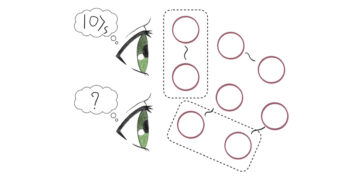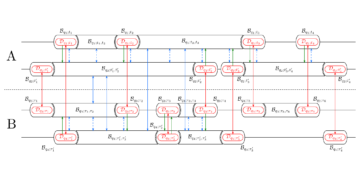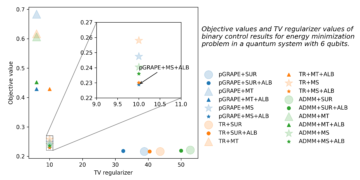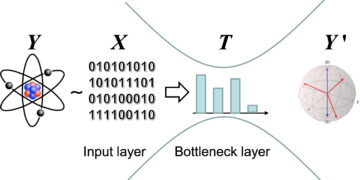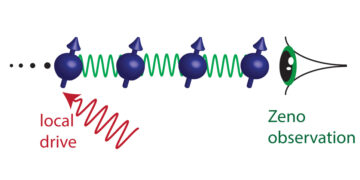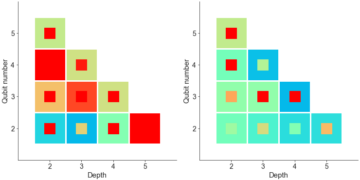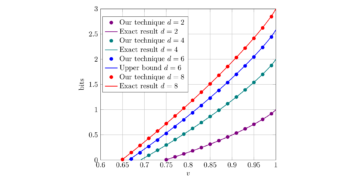1Centro de Física das Universidades do Minho e do Porto, Braga 4710-057, Portugal
2Institute of Theoretical Physics and IQST, Ulm University, Albert-Einstein-Allee 11, Ulm 89081, Germany
3International Iberian Nanotechnology Laboratory, Av. Mestre José Veiga s/n, Braga 4715-330, Portugal
4Laboratório de Física para Materiais e Tecnologias Emergentes (LaPMET), Universidade do Minho, Braga 4710-057, Portugal
5Departamento de Física, Universidade do Minho, Braga 4710-057, Portugal
6INESC TEC, Departamento de Informática, Universidade do Minho, Braga 4710-057, Portugal
Find this paper interesting or want to discuss? Scite or leave a comment on SciRate.
Abstract
Classical non-perturbative simulations of open quantum systems’ dynamics face several scalability problems, namely, exponential scaling of the computational effort as a function of either the time length of the simulation or the size of the open system. In this work, we propose the use of the Time Evolving Density operator with Orthogonal Polynomials Algorithm (TEDOPA) on a quantum computer, which we term as Quantum TEDOPA (Q-TEDOPA), to simulate non-perturbative dynamics of open quantum systems linearly coupled to a bosonic environment (continuous phonon bath). By performing a change of basis of the Hamiltonian, the TEDOPA yields a chain of harmonic oscillators with only local nearest-neighbour interactions, making this algorithm suitable for implementation on quantum devices with limited qubit connectivity such as superconducting quantum processors. We analyse in detail the implementation of the TEDOPA on a quantum device and show that exponential scalings of computational resources can potentially be avoided for time-evolution simulations of the systems considered in this work. We applied the proposed method to the simulation of the exciton transport between two light-harvesting molecules in the regime of moderate coupling strength to a non-Markovian harmonic oscillator environment on an IBMQ device. Applications of the Q-TEDOPA span problems which can not be solved by perturbation techniques belonging to different areas, such as the dynamics of quantum biological systems and strongly correlated condensed matter systems.
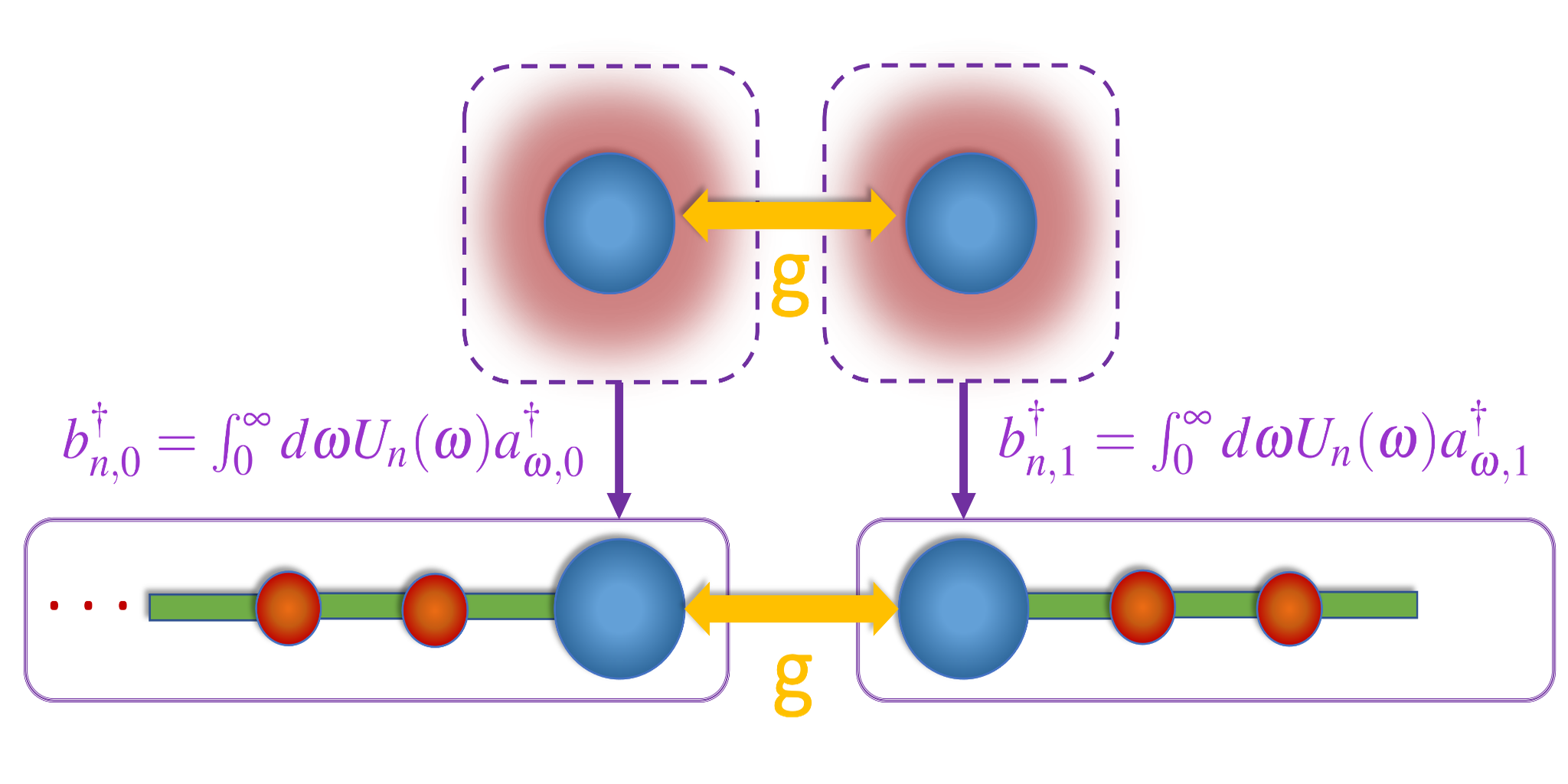
Popular summary
► BibTeX data
► References
[1] Yoshitaka Tanimura. “Numerically “exact” approach to open quantum dynamics: The hierarchical equations of motion (heom)”. J. Chem. Phys. 153, 020901 (2020). url: https://doi.org/10.1063/5.0011599.
https://doi.org/10.1063/5.0011599
[2] Akihito Ishizaki and Graham R Fleming. “Unified treatment of quantum coherent and incoherent hopping dynamics in electronic energy transfer: Reduced hierarchy equation approach”. J. Chem. Phys. 130, 234111 (2009). url: https://doi.org/10.1063/1.3155372.
https://doi.org/10.1063/1.3155372
[3] Kiyoto Nakamura and Yoshitaka Tanimura. “Optical response of laser-driven charge-transfer complex described by holstein–hubbard model coupled to heat baths: Hierarchical equations of motion approach”. J. Chem. Phys. 155, 064106 (2021). url: https://doi.org/10.1063/5.0060208.
https://doi.org/10.1063/5.0060208
[4] Alex W Chin, Susana F Huelga, and Martin B Plenio. “Chain representations of open quantum systems and their numerical simulation with time-adaptive density matrix renormalisation group methods”. In Semiconductors and Semimetals. Volume 85, pages 115–143. Elsevier (2011). url: https://doi.org/10.1016/B978-0-12-391060-8.00004-6.
https://doi.org/10.1016/B978-0-12-391060-8.00004-6
[5] Alex W Chin, Ángel Rivas, Susana F Huelga, and Martin B Plenio. “Exact mapping between system-reservoir quantum models and semi-infinite discrete chains using orthogonal polynomials”. J. Math. Phys. 51, 092109 (2010). url: https://doi.org/10.1063/1.3490188.
https://doi.org/10.1063/1.3490188
[6] Javier Prior, Alex W Chin, Susana F Huelga, and Martin B Plenio. “Efficient simulation of strong system-environment interactions”. Phys. Rev. Lett. 105, 050404 (2010). url: https://doi.org/10.1103/PhysRevLett.105.050404.
https://doi.org/10.1103/PhysRevLett.105.050404
[7] Dario Tamascelli, Andrea Smirne, Jaemin Lim, Susana F Huelga, and Martin B Plenio. “Efficient simulation of finite-temperature open quantum systems”. Phys. Rev. Lett. 123, 090402 (2019). url: https://doi.org/10.1103/PhysRevLett.123.090402.
https://doi.org/10.1103/PhysRevLett.123.090402
[8] Ulrich Schollwöck. “The density-matrix renormalization group in the age of matrix product states”. Ann. Phys. 326, 96–192 (2011). url: https://doi.org/10.1016/j.aop.2010.09.012.
https://doi.org/10.1016/j.aop.2010.09.012
[9] Jens Eisert, Marcus Cramer, and Martin B Plenio. “Colloquium: Area laws for the entanglement entropy”. Rev. Mod. Phys. 82, 277 (2010). url: https://doi.org/10.1103/RevModPhys.82.277.
https://doi.org/10.1103/RevModPhys.82.277
[10] Richard P Feynman. “Simulating physics with computers”. In Feynman and computation. Pages 133–153. CRC Press (2018). url: https://doi.org/10.1007/BF02650179.
https://doi.org/10.1007/BF02650179
[11] Google AI Quantum, Collaborators*†, Frank Arute, Kunal Arya, Ryan Babbush, Dave Bacon, Joseph C Bardin, Rami Barends, Sergio Boixo, Michael Broughton, Bob B Buckley, et al. “Hartree-fock on a superconducting qubit quantum computer”. Science 369, 1084–1089 (2020). url: https://doi.org/10.1126/science.abb981.
https://doi.org/10.1126/science.abb981
[12] Frank Arute, Kunal Arya, Ryan Babbush, Dave Bacon, Joseph C Bardin, Rami Barends, Andreas Bengtsson, Sergio Boixo, Michael Broughton, Bob B Buckley, et al. “Observation of separated dynamics of charge and spin in the fermi-hubbard model” (2020). url: https://doi.org/10.48550/arXiv.2010.07965.
https://doi.org/10.48550/arXiv.2010.07965
[13] Chengxi Ye, Christopher M Hill, Shigang Wu, Jue Ruan, and Zhanshan Sam Ma. “Dbg2olc: efficient assembly of large genomes using long erroneous reads of the third generation sequencing technologies”. Sci. Rep. 6, 1–9 (2016). url: https://doi.org/10.1038/srep31900.
https://doi.org/10.1038/srep31900
[14] Anthony W Schlimgen, Kade Head-Marsden, LeeAnn M Sager, Prineha Narang, and David A Mazziotti. “Quantum simulation of open quantum systems using a unitary decomposition of operators”. Phys. Rev. Lett. 127, 270503 (2021). url: https://doi.org/10.1103/PhysRevLett.127.270503.
https://doi.org/10.1103/PhysRevLett.127.270503
[15] Brian Rost, Lorenzo Del Re, Nathan Earnest, Alexander F Kemper, Barbara Jones, and James K Freericks. “Demonstrating robust simulation of driven-dissipative problems on near-term quantum computers” (2021). url: https://doi.org/10.48550/arXiv.2108.01183.
https://doi.org/10.48550/arXiv.2108.01183
[16] Sabine Tornow, Wolfgang Gehrke, and Udo Helmbrecht. “Non-equilibrium dynamics of a dissipative two-site hubbard model simulated on ibm quantum computers”. J. Phys. A: Math. Theor. 55, 245302 (2022). url: https://doi.org/10.1088/1751-8121/ac6bd0.
https://doi.org/10.1088/1751-8121/ac6bd0
[17] Guillermo García-Pérez, Matteo AC Rossi, and Sabrina Maniscalco. “Ibm q experience as a versatile experimental testbed for simulating open quantum systems”. npj Quantum Inf. 6, 1–10 (2020). url: https://doi.org/10.1038/s41534-019-0235-y.
https://doi.org/10.1038/s41534-019-0235-y
[18] Zixuan Hu, Kade Head-Marsden, David A Mazziotti, Prineha Narang, and Sabre Kais. “A general quantum algorithm for open quantum dynamics demonstrated with the fenna-matthews-olson complex”. Quantum 6, 726 (2022). url: https://doi.org/10.22331/q-2022-05-30-726.
https://doi.org/10.22331/q-2022-05-30-726
[19] Kade Head-Marsden, Stefan Krastanov, David A Mazziotti, and Prineha Narang. “Capturing non-markovian dynamics on near-term quantum computers”. Phys. Rev. Research 3, 013182 (2021). url: https://doi.org/10.1103/PhysRevResearch.3.013182.
https://doi.org/10.1103/PhysRevResearch.3.013182
[20] Suguru Endo, Jinzhao Sun, Ying Li, Simon C Benjamin, and Xiao Yuan. “Variational quantum simulation of general processes”. Phys. Rev. Lett. 125, 010501 (2020). url: https://doi.org/10.1103/PhysRevLett.125.010501.
https://doi.org/10.1103/PhysRevLett.125.010501
[21] Richard Cleve and Chunhao Wang. “Efficient quantum algorithms for simulating lindblad evolution” (2016). url: https://doi.org/10.48550/arXiv.1612.09512.
https://doi.org/10.48550/arXiv.1612.09512
[22] Xiao Yuan, Suguru Endo, Qi Zhao, Ying Li, and Simon C Benjamin. “Theory of variational quantum simulation”. Quantum 3, 191 (2019). url: https://doi.org/10.22331/q-2019-10-07-191.
https://doi.org/10.22331/q-2019-10-07-191
[23] Brian Rost, Barbara Jones, Mariya Vyushkova, Aaila Ali, Charlotte Cullip, Alexander Vyushkov, and Jarek Nabrzyski. “Simulation of thermal relaxation in spin chemistry systems on a quantum computer using inherent qubit decoherence” (2020). url: https://doi.org/10.48550/arXiv.2001.00794.
https://doi.org/10.48550/arXiv.2001.00794
[24] Shin Sun, Li-Chai Shih, and Yuan-Chung Cheng. “Efficient quantum simulation of open quantum system dynamics on noisy quantum computers” (2021). url: https://doi.org/10.48550/arXiv.2106.12882.
https://doi.org/10.48550/arXiv.2106.12882
[25] Hefeng Wang, Sahel Ashhab, and Franco Nori. “Quantum algorithm for simulating the dynamics of an open quantum system”. Phys. Rev. A 83, 062317 (2011). url: https://doi.org/10.1103/PhysRevA.101.012328.
https://doi.org/10.1103/PhysRevA.101.012328
[26] Bela Bauer, Dave Wecker, Andrew J Millis, Matthew B Hastings, and Matthias Troyer. “Hybrid quantum-classical approach to correlated materials”. Phys. Rev. X 6, 031045 (2016). url: https://doi.org/10.1103/PhysRevX.6.031045.
https://doi.org/10.1103/PhysRevX.6.031045
[27] Ivan Rungger, Nathan Fitzpatrick, Honxiang Chen, CH Alderete, Harriett Apel, Alexander Cowtan, Andrew Patterson, D Munoz Ramo, Yingyue Zhu, Nhung Hong Nguyen, et al. “Dynamical mean field theory algorithm and experiment on quantum computers” (2019). url: https://doi.org/10.48550/arXiv.1910.04735.
https://doi.org/10.48550/arXiv.1910.04735
[28] Agustin Di Paolo, Panagiotis Kl Barkoutsos, Ivano Tavernelli, and Alexandre Blais. “Variational quantum simulation of ultrastrong light-matter coupling”. Physical Review Research 2, 033364 (2020). url: https://doi.org/10.1103/PhysRevResearch.2.033364.
https://doi.org/10.1103/PhysRevResearch.2.033364
[29] Alexandru Macridin, Panagiotis Spentzouris, James Amundson, and Roni Harnik. “Digital quantum computation of fermion-boson interacting systems”. Phys. Rev. A 98, 042312 (2018). url: https://doi.org/10.1103/PhysRevA.98.042312.
https://doi.org/10.1103/PhysRevA.98.042312
[30] Hirsh Kamakari, Shi-Ning Sun, Mario Motta, and Austin J Minnich. “Digital quantum simulation of open quantum systems using quantum imaginary–time evolution”. PRX Quantum 3, 010320 (2022). url: https://doi.org/10.1103/PRXQuantum.3.010320.
https://doi.org/10.1103/PRXQuantum.3.010320
[31] José Diogo Guimarães, Carlos Tavares, Luís Soares Barbosa, and Mikhail I Vasilevskiy. “Simulation of nonradiative energy transfer in photosynthetic systems using a quantum computer”. Complexity 2020 (2020). url: https://doi.org/10.1155/2020/3510676.
https://doi.org/10.1155/2020/3510676
[32] Iulia M Georgescu, Sahel Ashhab, and Franco Nori. “Quantum simulation”. Rev. Mod. Phys. 86, 153 (2014). url: https://doi.org/10.1103/RevModPhys.86.153.
https://doi.org/10.1103/RevModPhys.86.153
[33] Heinz-Peter Breuer, Francesco Petruccione, et al. “The theory of open quantum systems”. Oxford University Press on Demand. (2002). url: https://doi.org/10.1093/acprof:oso/9780199213900.001.0001.
https://doi.org/10.1093/acprof:oso/9780199213900.001.0001
[34] Masoud Mohseni, Yasser Omar, Gregory S Engel, and Martin B Plenio. “Quantum effects in biology”. Cambridge University Press. (2014). url: https://doi.org/10.1017/CBO9780511863189.
https://doi.org/10.1017/CBO9780511863189
[35] Niklas Christensson, Harald F Kauffmann, Tonu Pullerits, and Tomas Mancal. “Origin of long-lived coherences in light-harvesting complexes”. J. Phys. Chem. B 116, 7449–7454 (2012). url: https://doi.org/10.1021/jp304649c.
https://doi.org/10.1021/jp304649c
[36] MI Vasilevskiy, EV Anda, and SS Makler. “Electron-phonon interaction effects in semiconductor quantum dots: A nonperturabative approach”. Phys. Rev. B 70, 035318 (2004). url: https://doi.org/10.1103/PhysRevB.70.035318.
https://doi.org/10.1103/PhysRevB.70.035318
[37] Mao Wang, Manuel Hertzog, and Karl Börjesson. “Polariton-assisted excitation energy channeling in organic heterojunctions”. Nat. Commun. 12, 1–10 (2021). url: https://doi.org/10.1038/s41467-021-22183-3.
https://doi.org/10.1038/s41467-021-22183-3
[38] Shahnawaz Rafiq, Bo Fu, Bryan Kudisch, and Gregory D Scholes. “Interplay of vibrational wavepackets during an ultrafast electron transfer reaction”. Nature Chemistry 13, 70–76 (2021). url: https://doi.org/10.1038/s41557-020-00607-9.
https://doi.org/10.1038/s41557-020-00607-9
[39] Walter Gautschi. “Algorithm 726: Orthpol–a package of routines for generating orthogonal polynomials and gauss-type quadrature rules”. TOMS 20, 21–62 (1994). url: https://doi.org/10.1145/174603.174605.
https://doi.org/10.1145/174603.174605
[40] MP Woods, R Groux, AW Chin, Susana F Huelga, and Martin B Plenio. “Mappings of open quantum systems onto chain representations and markovian embeddings”. J. Math. Phys. 55, 032101 (2014). url: https://doi.org/10.1063/1.4866769.
https://doi.org/10.1063/1.4866769
[41] Dario Tamascelli. “Excitation dynamics in chain-mapped environments”. Entropy 22, 1320 (2020). url: https://doi.org/10.3390/e22111320.
https://doi.org/10.3390/e22111320
[42] Nicolas PD Sawaya, Tim Menke, Thi Ha Kyaw, Sonika Johri, Alán Aspuru-Guzik, and Gian Giacomo Guerreschi. “Resource-efficient digital quantum simulation of d-level systems for photonic, vibrational, and spin-s hamiltonians”. npj Quantum Inf. 6, 1–13 (2020). url: https://doi.org/10.1038/s41534-020-0278-0.
https://doi.org/10.1038/s41534-020-0278-0
[43] Benjamin DM Jones, David R White, George O O’Brien, John A Clark, and Earl T Campbell. “Optimising trotter-suzuki decompositions for quantum simulation using evolutionary strategies”. In Proceedings of the Genetic and Evolutionary Computation Conference. Pages 1223–1231. (2019). url: https://doi.org/10.1145/3321707.3321835.
https://doi.org/10.1145/3321707.3321835
[44] Burak Şahinoğlu and Rolando D Somma. “Hamiltonian simulation in the low-energy subspace”. npj Quantum Inf. 7, 1–5 (2021). url: https://doi.org/10.1038/s41534-021-00451-w.
https://doi.org/10.1038/s41534-021-00451-w
[45] Dominic W Berry, Andrew M Childs, Richard Cleve, Robin Kothari, and Rolando D Somma. “Simulating hamiltonian dynamics with a truncated taylor series”. Phys. Rev. Lett. 114, 090502 (2015). url: https://doi.org/10.1103/PhysRevLett.114.090502.
https://doi.org/10.1103/PhysRevLett.114.090502
[46] Guang Hao Low and Isaac L Chuang. “Hamiltonian simulation by qubitization”. Quantum 3, 163 (2019). url: https://doi.org/10.22331/q-2019-07-12-163.
https://doi.org/10.22331/q-2019-07-12-163
[47] Ying Li and Simon C Benjamin. “Efficient variational quantum simulator incorporating active error minimization”. Phys. Rev. X 7, 021050 (2017). url: https://doi.org/10.1103/PhysRevX.7.021050.
https://doi.org/10.1103/PhysRevX.7.021050
[48] Cristina Cirstoiu, Zoe Holmes, Joseph Iosue, Lukasz Cincio, Patrick J Coles, and Andrew Sornborger. “Variational fast forwarding for quantum simulation beyond the coherence time”. npj Quantum Inf. 6, 1–10 (2020). url: https://doi.org/10.1038/s41534-020-00302-0.
https://doi.org/10.1038/s41534-020-00302-0
[49] Benjamin Commeau, Marco Cerezo, Zoë Holmes, Lukasz Cincio, Patrick J Coles, and Andrew Sornborger. “Variational hamiltonian diagonalization for dynamical quantum simulation” (2020). url: https://doi.org/10.48550/arXiv.2009.02559.
https://doi.org/10.48550/arXiv.2009.02559
[50] Stefano Barison, Filippo Vicentini, and Giuseppe Carleo. “An efficient quantum algorithm for the time evolution of parameterized circuits”. Quantum 5, 512 (2021). url: https://doi.org/10.22331/q-2021-07-28-512.
https://doi.org/10.22331/q-2021-07-28-512
[51] Noah F Berthusen, Thaís V Trevisan, Thomas Iadecola, and Peter P Orth. “Quantum dynamics simulations beyond the coherence time on noisy intermediate-scale quantum hardware by variational trotter compression”. Phys. Rev. Research 4, 023097 (2022). url: https://doi.org/10.1103/PhysRevResearch.4.023097.
https://doi.org/10.1103/PhysRevResearch.4.023097
[52] Mischa P Woods, M Cramer, and Martin B Plenio. “Simulating bosonic baths with error bars”. Phys. Rev. Lett. 115, 130401 (2015).
https://doi.org/10.1103/PhysRevLett.115.130401
[53] Alexander Nüßeler, Dario Tamascelli, Andrea Smirne, James Lim, Susana F Huelga, and Martin B Plenio. “Fingerprint and universal markovian closure of structured bosonic environments”. Phys. Rev. Lett. 129, 140604 (2022). url: https://doi.org/10.1103/PhysRevLett.129.140604.
https://doi.org/10.1103/PhysRevLett.129.140604
[54] Fabio Mascherpa, Andrea Smirne, Susana F Huelga, and Martin B Plenio. “Open systems with error bounds: spin-boson model with spectral density variations”. Phys. Rev. Lett. 118, 100401 (2017). url: https://doi.org/10.1103/PhysRevLett.118.100401.
https://doi.org/10.1103/PhysRevLett.118.100401
[55] Akel Hashim, Ravi K Naik, Alexis Morvan, Jean-Loup Ville, Bradley Mitchell, John Mark Kreikebaum, Marc Davis, Ethan Smith, Costin Iancu, Kevin P O’Brien, et al. “Randomized compiling for scalable quantum computing on a noisy superconducting quantum processor” (2020). url: https://doi.org/10.1103/PhysRevX.11.041039.
https://doi.org/10.1103/PhysRevX.11.041039
[56] Michael A Nielsen and Isaac Chuang. “Quantum computation and quantum information” (2002).
[57] Andrew M Childs, Dmitri Maslov, Yunseong Nam, Neil J Ross, and Yuan Su. “Toward the first quantum simulation with quantum speedup”. PNAS 115, 9456–9461 (2018). url: https://doi.org/10.1073/pnas.1801723115.
https://doi.org/10.1073/pnas.1801723115
[58] Andrew M Childs, Yuan Su, Minh C Tran, Nathan Wiebe, and Shuchen Zhu. “Theory of trotter error with commutator scaling”. Phys. Rev. X 11, 011020 (2021). url: https://doi.org/10.1103/PhysRevX.11.011020.
https://doi.org/10.1103/PhysRevX.11.011020
[59] Nathan Wiebe, Dominic Berry, Peter Høyer, and Barry C Sanders. “Higher order decompositions of ordered operator exponentials”. J. Phys. A: Math. Theor. 43, 065203 (2010). url: https://doi.org/10.1088/1751-8113/43/6/065203.
https://doi.org/10.1088/1751-8113/43/6/065203
[60] Minh C Tran, Yuan Su, Daniel Carney, and Jacob M Taylor. “Faster digital quantum simulation by symmetry protection”. PRX Quantum 2, 010323 (2021). url: https://doi.org/10.1103/PRXQuantum.2.010323.
https://doi.org/10.1103/PRXQuantum.2.010323
[61] Chi-Fang Chen, Hsin-Yuan Huang, Richard Kueng, and Joel A Tropp. “Concentration for random product formulas”. PRX Quantum 2, 040305 (2021). url: https://doi.org/10.1103/PRXQuantum.2.040305.
https://doi.org/10.1103/PRXQuantum.2.040305
[62] Angus J Dunnett, Duncan Gowland, Christine M Isborn, Alex W Chin, and Tim J Zuehlsdorff. “Influence of non-adiabatic effects on linear absorption spectra in the condensed phase: Methylene blue”. J. Chem. Phys. 155, 144112 (2021). url: https://doi.org/10.1063/5.0062950.
https://doi.org/10.1063/5.0062950
[63] Florian AYN Schröder and Alex W Chin. “Simulating open quantum dynamics with time-dependent variational matrix product states: Towards microscopic correlation of environment dynamics and reduced system evolution”. Phys. Rev. B 93, 075105 (2016).
https://doi.org/10.1103/PhysRevB.93.075105
[64] Javier Del Pino, Florian AYN Schröder, Alex W Chin, Johannes Feist, and Francisco J Garcia-Vidal. “Tensor network simulation of non-markovian dynamics in organic polaritons”. Phys. Rev. Lett. 121, 227401 (2018). url: https://doi.org/10.1103/PhysRevLett.121.227401.
https://doi.org/10.1103/PhysRevLett.121.227401
[65] Suryanarayanan Chandrasekaran, Mortaza Aghtar, Stéphanie Valleau, Alán Aspuru-Guzik, and Ulrich Kleinekathöfer. “Influence of force fields and quantum chemistry approach on spectral densities of bchl a in solution and in fmo proteins”. J. Phys. Chem. B 119, 9995–10004 (2015). url: https://doi.org/10.1021/acs.jpcb.5b03654.
https://doi.org/10.1021/acs.jpcb.5b03654
[66] Akihito Ishizaki and Graham R Fleming. “Theoretical examination of quantum coherence in a photosynthetic system at physiological temperature”. PNAS 106, 17255–17260 (2009). url: https://doi.org/10.1073/pnas.0908989106.
https://doi.org/10.1073/pnas.0908989106
[67] Erling Thyrhaug, Roel Tempelaar, Marcelo JP Alcocer, Karel Žídek, David Bína, Jasper Knoester, Thomas LC Jansen, and Donatas Zigmantas. “Identification and characterization of diverse coherences in the fenna–matthews–olson complex”. Nat. Chem. 10, 780–786 (2018). url: https://doi.org/10.1038/s41557-018-0060-5.
https://doi.org/10.1038/s41557-018-0060-5
[68] Matthew P Harrigan, Kevin J Sung, Matthew Neeley, Kevin J Satzinger, Frank Arute, Kunal Arya, Juan Atalaya, Joseph C Bardin, Rami Barends, Sergio Boixo, et al. “Quantum approximate optimization of non-planar graph problems on a planar superconducting processor”. Nat. Phys. 17, 332–336 (2021). url: https://doi.org/10.1038/s41567-020-01105-y.
https://doi.org/10.1038/s41567-020-01105-y
[69] Alex W Chin, J Prior, R Rosenbach, F Caycedo-Soler, Susana F Huelga, and Martin B Plenio. “The role of non-equilibrium vibrational structures in electronic coherence and recoherence in pigment–protein complexes”. Nat. Phys. 9, 113–118 (2013). url: https://doi.org/10.1038/nphys2515.
https://doi.org/10.1038/nphys2515
[70] Youngseok Kim, Andrew Eddins, Sajant Anand, Ken Xuan Wei, Ewout Van Den Berg, Sami Rosenblatt, Hasan Nayfeh, Yantao Wu, Michael Zaletel, Kristan Temme, et al. “Evidence for the utility of quantum computing before fault tolerance”. Nature 618, 500–505 (2023). url: https://doi.org/10.1038/s41586-023-06096-3.
https://doi.org/10.1038/s41586-023-06096-3
[71] Ewout Van Den Berg, Zlatko K Minev, Abhinav Kandala, and Kristan Temme. “Probabilistic error cancellation with sparse pauli–lindblad models on noisy quantum processors”. Nat. Phys.Pages 1–6 (2023). url: https://doi.org/10.1038/s41567-023-02042-2.
https://doi.org/10.1038/s41567-023-02042-2
[72] James Dborin, Vinul Wimalaweera, Fergus Barratt, Eric Ostby, Thomas E O’Brien, and Andrew G Green. “Simulating groundstate and dynamical quantum phase transitions on a superconducting quantum computer”. Nat. Commun. 13, 5977 (2022). url: https://doi.org/10.1038/s41467-022-33737-4.
https://doi.org/10.1038/s41467-022-33737-4
[73] Jan Jeske, David J Ing, Martin B Plenio, Susana F Huelga, and Jared H Cole. “Bloch-redfield equations for modeling light-harvesting complexes”. J. Chem. Phys. 142, 064104 (2015). url: https://doi.org/10.1063/1.4907370.
https://doi.org/10.1063/1.4907370
[74] Zeng-Zhao Li, Liwen Ko, Zhibo Yang, Mohan Sarovar, and K Birgitta Whaley. “Interplay of vibration-and environment-assisted energy transfer”. New J. Phys. 24, 033032 (2022). url: https://doi.org/10.1088/1367-2630/ac5841.
https://doi.org/10.1088/1367-2630/ac5841
[75] Andrew Cross. “The ibm q experience and qiskit open-source quantum computing software”. In APS March meeting abstracts. Volume 2018, pages L58–003. (2018). url: https://ui.adsabs.harvard.edu/abs/2018APS..MARL58003.
https://ui.adsabs.harvard.edu/abs/2018APS..MARL58003
[76] Joel J Wallman and Joseph Emerson. “Noise tailoring for scalable quantum computation via randomized compiling”. Phys. Rev. A 94, 052325 (2016). url: https://doi.org/10.1103/PhysRevA.94.052325.
https://doi.org/10.1103/PhysRevA.94.052325
[77] Tudor Giurgica-Tiron, Yousef Hindy, Ryan LaRose, Andrea Mari, and William J Zeng. “Digital zero noise extrapolation for quantum error mitigation”. In 2020 IEEE Int. Conf. on QCE. Pages 306–316. IEEE (2020). url: https://doi.org/10.1109/QCE49297.2020.00045.
https://doi.org/10.1109/QCE49297.2020.00045
[78] Vincent R Pascuzzi, Andre He, Christian W Bauer, Wibe A De Jong, and Benjamin Nachman. “Computationally efficient zero-noise extrapolation for quantum-gate-error mitigation”. Phys. Rev. A 105, 042406 (2022). url: https://doi.org/10.1103/PhysRevA.105.042406.
https://doi.org/10.1103/PhysRevA.105.042406
[79] Zhenyu Cai. “Multi-exponential error extrapolation and combining error mitigation techniques for nisq applications”. npj Quantum Inf. 7, 1–12 (2021). url: https://doi.org/10.1038/s41534-021-00404-3.
https://doi.org/10.1038/s41534-021-00404-3
[80] Ryan LaRose, Andrea Mari, Sarah Kaiser, Peter J Karalekas, Andre A Alves, Piotr Czarnik, Mohamed El Mandouh, Max H Gordon, Yousef Hindy, Aaron Robertson, et al. “Mitiq: A software package for error mitigation on noisy quantum computers”. Quantum 6, 774 (2022). url: https://doi.org/10.22331/q-2022-08-11-774.
https://doi.org/10.22331/q-2022-08-11-774
[81] Suguru Endo, Zhenyu Cai, Simon C Benjamin, and Xiao Yuan. “Hybrid quantum-classical algorithms and quantum error mitigation”. J. Phys. Soc. Jpn. 90, 032001 (2021). url: https://doi.org/10.7566/JPSJ.90.032001.
https://doi.org/10.7566/JPSJ.90.032001
[82] Mónica Sánchez-Barquilla and Johannes Feist. “Accurate truncations of chain mapping models for open quantum systems”. Nanomaterials 11, 2104 (2021). url: https://doi.org/10.3390/nano11082104.
https://doi.org/10.3390/nano11082104
[83] Ville Bergholm, Josh Izaac, Maria Schuld, Christian Gogolin, M Sohaib Alam, Shahnawaz Ahmed, Juan Miguel Arrazola, Carsten Blank, Alain Delgado, Soran Jahangiri, et al. “Pennylane: Automatic differentiation of hybrid quantum-classical computations” (2018). url: https://doi.org/10.48550/arXiv.1811.04968.
https://doi.org/10.48550/arXiv.1811.04968
[84] Julia Adolphs and Thomas Renger. “How proteins trigger excitation energy transfer in the fmo complex of green sulfur bacteria”. Biophys. J. 91, 2778–2797 (2006). url: https://doi.org/10.1529/biophysj.105.079483.
https://doi.org/10.1529/biophysj.105.079483
[85] Gregory S Engel, Tessa R Calhoun, Elizabeth L Read, Tae-Kyu Ahn, Tomáš Mančal, Yuan-Chung Cheng, Robert E Blankenship, and Graham R Fleming. “Evidence for wavelike energy transfer through quantum coherence in photosynthetic systems”. Nature 446, 782–786 (2007). url: https://doi.org/10.1038/nature05678.
https://doi.org/10.1038/nature05678
[86] Gitt Panitchayangkoon, Dugan Hayes, Kelly A Fransted, Justin R Caram, Elad Harel, Jianzhong Wen, Robert E Blankenship, and Gregory S Engel. “Long-lived quantum coherence in photosynthetic complexes at physiological temperature”. PNAS 107, 12766–12770 (2010). url: https://doi.org/10.1073/pnas.1005484107.
https://doi.org/10.1073/pnas.1005484107
[87] Jakub Dostál, Jakub Pšenčík, and Donatas Zigmantas. “In situ mapping of the energy flow through the entire photosynthetic apparatus”. Nat. Chem. 8, 705–710 (2016). url: https://doi.org/10.1038/nchem.2525.
https://doi.org/10.1038/nchem.2525
Cited by
[1] José D. Guimarães, James Lim, Mikhail I. Vasilevskiy, Susana F. Huelga, and Martin B. Plenio, “Noise-Assisted Digital Quantum Simulation of Open Systems Using Partial Probabilistic Error Cancellation”, PRX Quantum 4 4, 040329 (2023).
[2] Jonathon P. Misiewicz and Francesco A. Evangelista, “Implementation of the Projective Quantum Eigensolver on a Quantum Computer”, arXiv:2310.04520, (2023).
[3] Anthony W. Schlimgen, Kade Head-Marsden, LeeAnn M. Sager-Smith, Prineha Narang, and David A. Mazziotti, “Quantum state preparation and nonunitary evolution with diagonal operators”, Physical Review A 106 2, 022414 (2022).
The above citations are from SAO/NASA ADS (last updated successfully 2024-02-06 14:54:30). The list may be incomplete as not all publishers provide suitable and complete citation data.
On Crossref’s cited-by service no data on citing works was found (last attempt 2024-02-06 14:54:29).
This Paper is published in Quantum under the Creative Commons Attribution 4.0 International (CC BY 4.0) license. Copyright remains with the original copyright holders such as the authors or their institutions.
- SEO Powered Content & PR Distribution. Get Amplified Today.
- PlatoData.Network Vertical Generative Ai. Empower Yourself. Access Here.
- PlatoAiStream. Web3 Intelligence. Knowledge Amplified. Access Here.
- PlatoESG. Carbon, CleanTech, Energy, Environment, Solar, Waste Management. Access Here.
- PlatoHealth. Biotech and Clinical Trials Intelligence. Access Here.
- Source: https://quantum-journal.org/papers/q-2024-02-05-1242/
- :is
- :not
- :where
- ][p
- $UP
- 001
- 012
- 09
- 1
- 10
- 107
- 11
- 114
- 116
- 118
- 12
- 121
- 125
- 127
- 13
- 130
- 14
- 15%
- 16
- 17
- 19
- 1994
- 2%
- 20
- 2001
- 2006
- 2009
- 2010
- 2011
- 2012
- 2013
- 2014
- 2015
- 2016
- 2017
- 2018
- 2019
- 2020
- 2021
- 2022
- 2023
- 21
- 22
- 23
- 24
- 25
- 26
- 27
- 28
- 29
- 30
- 31
- 32
- 33
- 34
- 35%
- 36
- 39
- 4
- 40
- 41
- 42
- 45
- 46
- 48
- 49
- 5
- 50
- 51
- 52
- 54
- 55
- 58
- 6
- 60
- 62
- 65
- 66
- 67
- 7
- 70
- 72
- 73
- 74
- 75
- 77
- 8
- 80
- 84
- 87
- 9
- 90
- 91
- 98
- a
- Aaron
- above
- ABSTRACT
- abstracts
- AC
- access
- Achieve
- active
- adaptation
- affiliations
- age
- ahmed
- AI
- AL
- alex
- Alexander
- algorithm
- algorithms
- All
- an
- analyse
- analyze
- and
- andre
- andrea
- Andrew
- ann
- Anthony
- applications
- applied
- approach
- approximate
- ARE
- AREA
- areas
- AS
- Assembly
- At
- attempt
- austin
- author
- authors
- Automatic
- AV
- avoided
- b
- Bacteria
- barry
- bars
- basis
- BE
- before
- belonging
- Benjamin
- between
- Beyond
- biology
- Blue
- Bo
- bob
- bounds
- Break
- Brian
- Bryan
- by
- cambridge
- campbell
- CAN
- capabilities
- carlos
- chain
- chains
- change
- charge
- Charlotte
- chemistry
- chen
- Cheng
- chin
- christian
- Christine
- Christopher
- circuits
- citing
- closure
- COHERENT
- combining
- comment
- Commons
- compared
- complete
- complex
- complexity
- computation
- computational
- computations
- computer
- computers
- computing
- Condensed matter
- Conference
- Connectivity
- considered
- continuous
- copyright
- correlated
- Correlation
- Counterpart
- coupled
- CRC
- Cross
- Daniel
- data
- Dave
- David
- Davis
- de
- decompositions
- del
- Demand
- demonstrate
- demonstrated
- Den
- density
- described
- designed
- detail
- device
- Devices
- different
- digital
- discrete
- discuss
- diverse
- DM
- do
- dominic
- duncan
- during
- dynamics
- e
- E&T
- earnest
- effects
- efficient
- effort
- either
- el
- Electronic
- energy
- enhancing
- entanglement
- Entire
- Environment
- environments
- equation
- equations
- eric
- error
- ethan
- Ether (ETH)
- EV
- evolution
- evolving
- examination
- experience
- experiment
- experimental
- exponential
- Face
- FAST
- fault
- Feb
- fergus
- field
- Fields
- First
- Fitzpatrick
- flow
- For
- Force
- formulas
- found
- Francisco
- frank
- from
- fu
- function
- General
- generating
- generation
- genetic
- George
- giuseppe
- google ai
- gordon
- graham
- graph
- Green
- Group
- Hardware
- harvard
- he
- hierarchy
- holders
- Hong
- HTTPS
- huang
- Hybrid
- hybrid quantum-classical
- i
- IBM
- ibm quantum
- IEEE
- imaginary
- implementation
- in
- incorporating
- information
- ING
- inherent
- institutions
- interacting
- interaction
- interactions
- interesting
- International
- Introduces
- ITS
- ivan
- jacob
- james
- Jan
- JavaScript
- John
- jones
- journal
- jp
- juan
- julia
- Justin
- karl
- Kim
- laboratory
- large
- Last
- Laws
- Leave
- Length
- li
- License
- Limited
- linear
- linearly
- List
- local
- Long
- Low
- Making
- manuel
- mapping
- March
- Marco
- Marcus
- maria
- Mario
- mark
- Martin
- materials
- math
- Matrix
- Matter
- matthew
- matthias
- max
- max-width
- May..
- mean
- meeting
- method
- methods
- Michael
- microscopic
- mikhail
- minimization
- mitigation
- model
- modeling
- models
- moderate
- Mohamed
- Month
- more
- motion
- Nam
- namely
- Nanomaterials
- nanotechnology
- Nature
- network
- New
- Nguyen
- Nicolas
- no
- Noah
- Noise
- numerical
- of
- omar
- on
- only
- onto
- open
- open source
- operator
- operators
- optimization
- or
- order
- organic
- original
- Oxford
- oxford university
- package
- pages
- Paolo
- Paper
- PARA
- partial
- patrick
- performing
- Peter
- phase
- physical
- Physics
- plato
- Plato Data Intelligence
- PlatoData
- polynomials
- potentially
- preparation
- press
- Prior
- problems
- Proceedings
- processes
- Processor
- processors
- Product
- promise
- propose
- proposed
- protection
- Proteins
- provide
- providing
- published
- publisher
- publishers
- Qi
- qiskit
- Quantum
- quantum algorithms
- Quantum Computer
- quantum computers
- quantum computing
- Quantum dots
- quantum information
- quantum systems
- Qubit
- qubits
- R
- RAMI
- random
- Randomized
- RE
- reaction
- Read
- real
- Reduced
- references
- regime
- relatively
- relaxation
- remains
- requires
- research
- Resources
- response
- restricted
- review
- Richard
- ROBERT
- Robin
- robust
- Role
- routines
- rules
- Ryan
- s
- Sam
- sanders
- Scalability
- scalable
- scaling
- SCI
- Science
- semiconductor
- Semiconductors
- sequencing
- Series
- several
- show
- Shows
- Simon
- simulate
- simulation
- simulations
- simulator
- Size
- smith
- Software
- solution
- span
- sparse
- Spectral
- Spin
- State
- States
- stefan
- strategies
- strength
- strong
- strongly
- structured
- structures
- Successfully
- such
- suggest
- suitable
- Sun
- sung
- symmetry
- system
- Systems
- T
- tailoring
- taylor
- techniques
- Technologies
- term
- that
- The
- their
- theoretical
- theory
- thermal
- Third
- Third Generation
- this
- Through
- Tim
- time
- Title
- to
- tolerance
- towards
- transfer
- transitions
- transport
- treatment
- trigger
- two
- under
- Universal
- university
- updated
- URL
- use
- using
- utility
- variations
- versatile
- via
- vincent
- volume
- W
- wang
- want
- was
- we
- which
- white
- william
- with
- Woods
- Work
- works
- wu
- X
- xiao
- ye
- year
- yields
- YING
- Yuan
- zephyrnet
- zero
- Zhao

